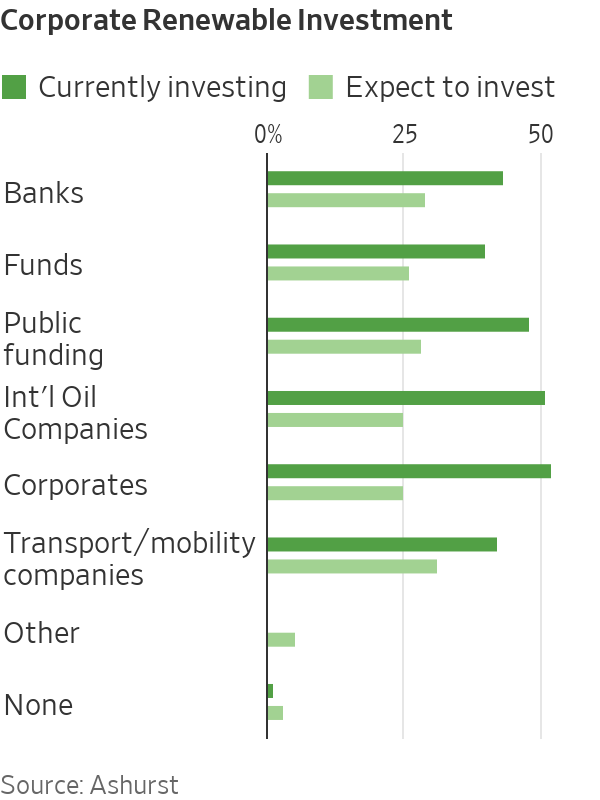Companies Say Push to Decarbonise Comes From Their Own Boards
Call to cut corporate carbon footprints is loudest from inside organizations, outweighing demand from customers and regulators, survey finds
The pressure on companies to cut their carbon footprint is coming more from within the organisations themselves than from customers and regulators, according to a new report.
Three-quarters of business leaders from across the Group of 20 nations said the push to invest in renewable energy is being driven mainly by their own corporate boards, with 77% of U.S. business leaders saying the pressure was extreme or significant, according to a new survey conducted by law firm Ashurst.
The corporate call to decarbonise is intensifying, Ashurst said, with 30% of business leaders saying the pressure from their own boards was extreme, up from 25% in 2022.
“We’re seeing that the energy transition is an area that is firmly embedded in the thinking of investors, corporates, governments and others, so there is a real emphasis on setting and acting on these plans now,” said Michael Burns, global co-head of energy at Ashurst. “That said, the pace of transition and the stage of the journey very much depends from business to business.”
The shift in sentiment comes as companies ramp up investment in renewable spending to meet their net-zero goals. Ashurst found that 71% of the more than 2,000 respondents to its survey had committed to a net-zero target, while 26% of respondents said their targets were under development.
Ashurst also found that solar was the most popular method to decarbonise, with 72% of respondents currently investing in or committed to investing in the clean energy technology. The law firm also found that companies tended to be the most active when it comes to renewable investments, with 52% of the respondents falling into this category. The average turnover of those companies was $15.1 billion.

Meanwhile, 81% of energy-sector respondents to the survey said they see investment in renewables as essential to the organisation’s strategic growth.
Burns said the 2030 timeline to reach net zero was very important to the companies it surveyed. “We are increasingly seeing corporate and other stakeholders actively setting and embracing trajectories to achieve net zero. However, greater clarity and transparency on the standards for measuring and managing these net-zero commitments is needed to ensure consistency in approach and, importantly, outcome,” he said.
Legal battles over climate change and renewable investing are also likely to rise, with 68% of respondents saying they expect to see an increase in legal disputes over the next five years, while only 16% anticipate a decrease, the report said.
 Copyright 2020, Dow Jones & Company, Inc. All Rights Reserved Worldwide. LEARN MORE
Copyright 2020, Dow Jones & Company, Inc. All Rights Reserved Worldwide. LEARN MORE
This stylish family home combines a classic palette and finishes with a flexible floorplan
Just 55 minutes from Sydney, make this your creative getaway located in the majestic Hawkesbury region.
Continued stagflation and cost of living pressures are causing couples to think twice about starting a family, new data has revealed, with long term impacts expected
Australia is in the midst of a ‘baby recession’ with preliminary estimates showing the number of births in 2023 fell by more than four percent to the lowest level since 2006, according to KPMG. The consultancy firm says this reflects the impact of cost-of-living pressures on the feasibility of younger Australians starting a family.
KPMG estimates that 289,100 babies were born in 2023. This compares to 300,684 babies in 2022 and 309,996 in 2021, according to the Australian Bureau of Statistics (ABS). KPMG urban economist Terry Rawnsley said weak economic growth often leads to a reduced number of births. In 2023, ABS data shows gross domestic product (GDP) fell to 1.5 percent. Despite the population growing by 2.5 percent in 2023, GDP on a per capita basis went into negative territory, down one percent over the 12 months.
“Birth rates provide insight into long-term population growth as well as the current confidence of Australian families,” said Mr Rawnsley. “We haven’t seen such a sharp drop in births in Australia since the period of economic stagflation in the 1970s, which coincided with the initial widespread adoption of the contraceptive pill.”
Mr Rawnsley said many Australian couples delayed starting a family while the pandemic played out in 2020. The number of births fell from 305,832 in 2019 to 294,369 in 2020. Then in 2021, strong employment and vast amounts of stimulus money, along with high household savings due to lockdowns, gave couples better financial means to have a baby. This led to a rebound in births.
However, the re-opening of the global economy in 2022 led to soaring inflation. By the start of 2023, the Australian consumer price index (CPI) had risen to its highest level since 1990 at 7.8 percent per annum. By that stage, the Reserve Bank had already commenced an aggressive rate-hiking strategy to fight inflation and had raised the cash rate every month between May and December 2022.
Five more rate hikes during 2023 put further pressure on couples with mortgages and put the brakes on family formation. “This combination of the pandemic and rapid economic changes explains the spike and subsequent sharp decline in birth rates we have observed over the past four years,” Mr Rawnsley said.
The impact of high costs of living on couples’ decision to have a baby is highlighted in births data for the capital cities. KPMG estimates there were 60,860 births in Sydney in 2023, down 8.6 percent from 2019. There were 56,270 births in Melbourne, down 7.3 percent. In Perth, there were 25,020 births, down 6 percent, while in Brisbane there were 30,250 births, down 4.3 percent. Canberra was the only capital city where there was no fall in the number of births in 2023 compared to 2019.
“CPI growth in Canberra has been slightly subdued compared to that in other major cities, and the economic outlook has remained strong,” Mr Rawnsley said. “This means families have not been hurting as much as those in other capital cities, and in turn, we’ve seen a stabilisation of births in the ACT.”
This stylish family home combines a classic palette and finishes with a flexible floorplan
Just 55 minutes from Sydney, make this your creative getaway located in the majestic Hawkesbury region.






















